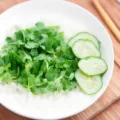Kimchi, the traditional Korean dish of fermented vegetables, has gained global popularity for its unique flavors and health benefits. In this article, we’ll share a simple recipe from a celebrity chef that you can easily follow at home. This homemade kimchi recipe is not only delicious but also packed with probiotics, vitamins, and minerals.
Ingredients for Homemade Kimchi
- 1 medium napa cabbage
- 1/4 cup sea salt
- 2 cups water
- 1 tablespoon grated ginger
- 4 cloves garlic, minced
- 1 tablespoon sugar
- 2 tablespoons fish sauce (optional)
- 1 tablespoon Korean red chili pepper flakes (gochugaru)
- 4 green onions, chopped
- 1 medium carrot, julienned
- 1 daikon radish, julienned
Step-by-Step Instructions
Step 1: Prepare the Cabbage
Start by cutting the napa cabbage into quarters and removing the core. Chop the cabbage into bite-sized pieces and place them in a large bowl. Dissolve the sea salt in 2 cups of water and pour it over the cabbage. Toss the cabbage to ensure it is evenly coated with the salt water. Let it sit for 1-2 hours, tossing occasionally.
Step 2: Make the Kimchi Paste
While the cabbage is soaking, prepare the kimchi paste. In a small bowl, combine the grated ginger, minced garlic, sugar, fish sauce (if using), and Korean red chili pepper flakes. Mix well to form a paste.
Step 3: Rinse and Drain the Cabbage
After the cabbage has soaked, rinse it thoroughly under cold running water to remove the excess salt. Drain the cabbage well and gently squeeze out any remaining water.
Step 4: Combine the Ingredients
In a large mixing bowl, combine the drained cabbage, chopped green onions, julienned carrot, and julienned daikon radish. Add the kimchi paste and mix everything together, ensuring that the vegetables are evenly coated with the paste.
Step 5: Ferment the Kimchi
Transfer the kimchi mixture into a clean, airtight container or jar, pressing down firmly to remove any air bubbles. Leave some space at the top of the container to allow for expansion during fermentation. Seal the container and let it sit at room temperature for 1-2 days, depending on your preferred level of fermentation. Once the kimchi has reached your desired taste, transfer it to the refrigerator. It will continue to ferment slowly and develop more complex flavors over time.
Health Benefits of Kimchi
Kimchi is not only a flavorful addition to your meals but also offers numerous health benefits. It is rich in probiotics, which promote a healthy gut microbiome and improve digestion. Kimchi also contains vitamins A, B, and C, as well as fiber and antioxidants that support overall health and well-being.
Tips for Perfect Kimchi
- Use fresh, high-quality ingredients for the best flavor and nutritional value.
- Adjust the amount of chili pepper flakes to suit your spice tolerance.
- Ensure all equipment and containers are clean to prevent contamination.
- Taste the kimchi during the fermentation process to find your preferred level of tanginess.
FAQ
1. How long does homemade kimchi last?
Homemade kimchi can last for several months when stored in the refrigerator. The flavor will continue to develop over time, becoming more tangy and complex.
2. Can I make kimchi without fish sauce?
Yes, you can make kimchi without fish sauce. Substitute it with soy sauce or omit it entirely for a vegetarian or vegan version.
3. What can I do if my kimchi is too salty?
If your kimchi is too salty, rinse it with cold water before serving to reduce the saltiness. You can also add more fresh vegetables to balance the flavor.
4. How can I tell if my kimchi has gone bad?
Kimchi should have a tangy, slightly sour smell. If it develops an off-putting odor, mold, or an unusual color, it is best to discard it.
5. Can I use other vegetables in kimchi?
Yes, you can experiment with different vegetables such as cucumbers, radishes, or even fruits like apples and pears to create unique kimchi variations.









